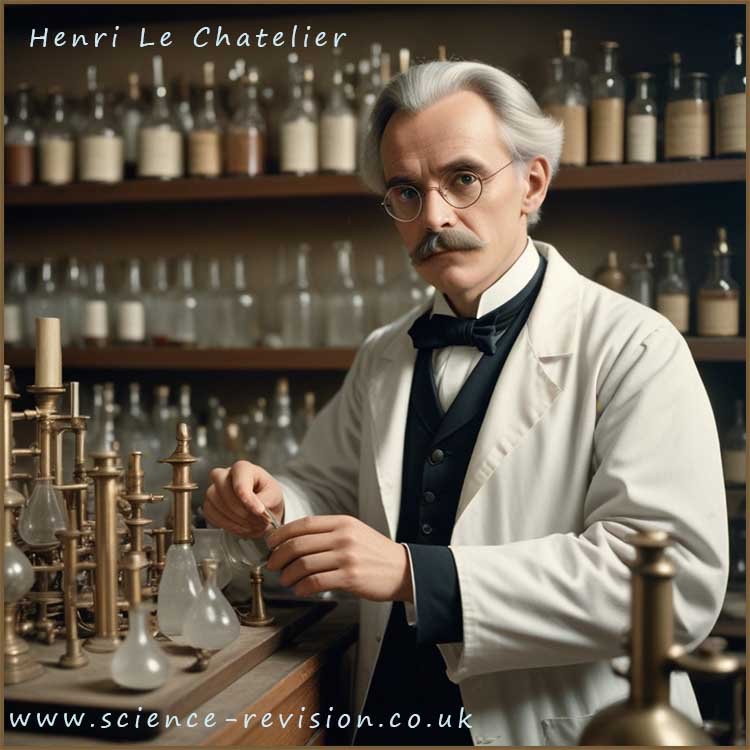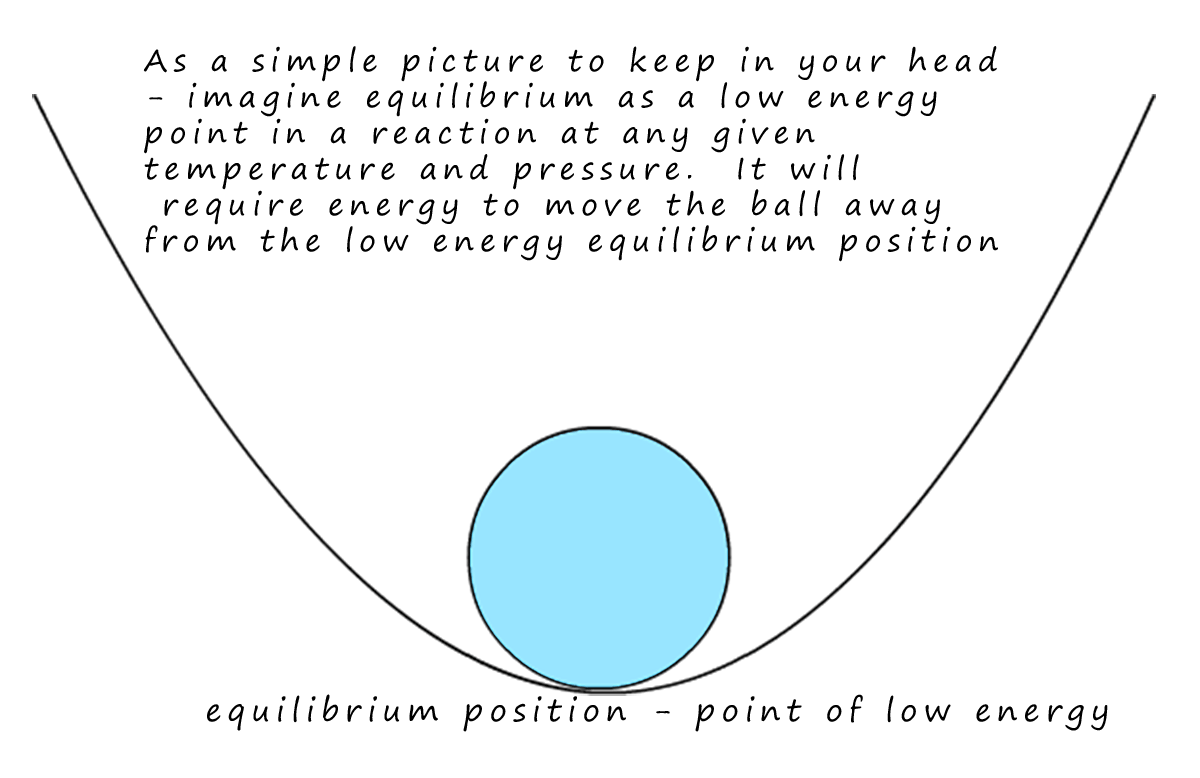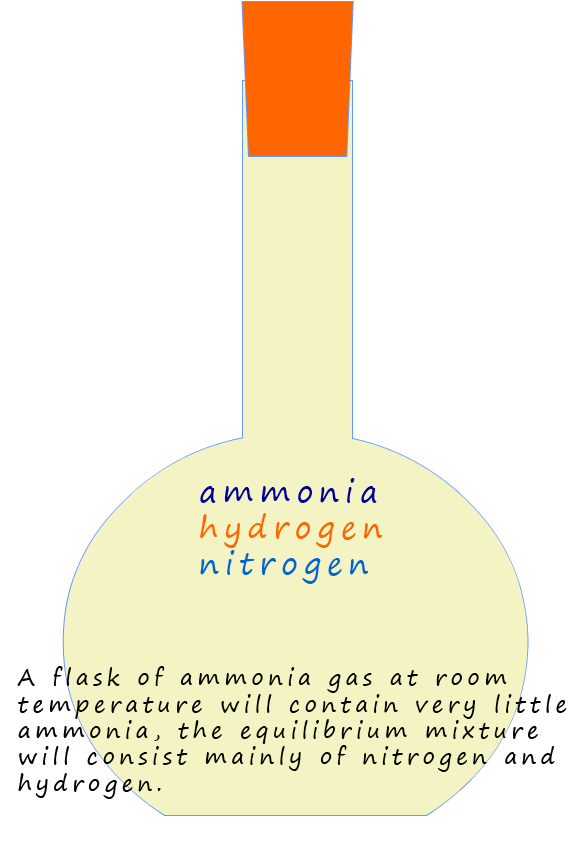

Henry Le Chatelier was a pioneering French chemist born in 1850, whose work and research have enable scientists to better understand chemical equilibrium. His most famous contribution is perhaps the principle that bears his name, Le Chatelier's Principle. This is a theory to help chemists and other scientists understanding how chemical systems (the reacting chemicals) at equilibrium respond to changes in the reaction conditions, whether it be changes in the temperature, pressure, or concentration of a reactant or product. In essence, this principle states that a chemical system will change its composition to minimise the effect of any changes in temperature, pressure or concentration that are made to any of the substances involved in the equilibrium reaction.
Equilibrium is the point in a reversible reaction where the rate of the forward (Rf) reaction and reverse reactions (Rb) are the same.
We can show this as:
 During a reversible reaction the reactants turn into products and the products back into reactants again. The
important point to remember is that these two reactions are occurring at the same time. The forward reaction will proceed at
a given rate; labelled Rf and the back reaction which turns products back into reactants will also proceed at a given rate; labelled
Rb in the example below.
During a reversible reaction the reactants turn into products and the products back into reactants again. The
important point to remember is that these two reactions are occurring at the same time. The forward reaction will proceed at
a given rate; labelled Rf and the back reaction which turns products back into reactants will also proceed at a given rate; labelled
Rb in the example below.

When a chemical reaction starts usually the rate of the forward reaction is very fast; this is simply because there are lots of reactant particles around to collide and react with each other. However as the reaction proceeds the rate of the forward reaction (Rf) will start to slow down as the amount of reactants particles available to react reduces. The opposite is true for the back reaction; to begin with there will not be many products particles available to react with each other but as the reaction proceeds the amounts of products present will gradually increase and the rate of the back reaction (Rb) will increase. Eventually after a certain period of time the rate of the forward and reverse reactions will be the same.
Imagine looking a reversible chemical reaction where the rates of the forward and reverse reactions were the same; what do you think you would see happening? Well as quickly as the reactants are turning into products the products are turning back into reactants, so the amounts of the reactants and products will not be changing. The reaction might appear as if it has stopped but it has NOT. The reactants are turning into products and the products are turning back into reactants at the same rate; the reaction most definitely has not stopped; it has reached a balance point where the rates of the forward and reverse reactions are the same. As a chemist we would say the reaction has reached or achieved dynamic equilibrium. The word equilibrium implies balance and dynamic implies movement. The reaction has reached equilibrium because Rf=Rb but the reaction is still occurring, its dynamic!

From the work you have done on rates of reaction you probably already know that it is possible to change the rate of a reaction by say heating it up or increasing the concentration of a particular reactant, adding a catalyst or increasing the surface area of a reacting substance. A common misconception that a lot of students have is that if a reaction has achieved dynamic equilibrium then it consists of a 50:50 mixture of reactants and products; however this is rarely the case.
Equilibrium is a very stable low energy point for a reaction; at
equilibrium the reaction is nice
and happy!! It's like the ball at the bottom of the curve. If you push on it so that it
moves away from the bottom of the curve the ball will roll back down again; to the low energy point.
Well chemical reactions are a bit like that!- if a reaction is at equilibrium (rate of forward and
reverse reactions are the same) and you come along and heat it up or put it under
pressure the
reaction and generally annoy it then the reaction will re-adjust itself to get back to a new equilibrium position; that is a new low energy state.
At this new equilibrium
position the amounts of reactants and products may be different but the rate of the forward and reverse
reactions will be the same e.g. consider the reaction of nitrogen and hydrogen to make ammonia; the Haber process.
At equilibrium the mixture contains only a small amount of ammonia and is mostly nitrogen and hydrogen.
We would say the position of equilibrium lies to the
left; that is on the reactants side. Since ammonia is a useful substance we need to shift the position of
equilibrium so
that it moves more to the right, that is the equilibrium mixture has a larger percentage of ammonia; the product present.
The position of equilibrium for a reaction depends on several variables; these include concentration,
temperature
and pressure if gases are involved in the reaction.
We can adjust the amounts of reactants and products at equilibrium by simply changing the reaction conditions.
The trick is to know exactly what conditions to change in order to change the position of equilibrium and the amounts of the reactants and products present and that is exactly what Henri Le Chatelier figured out.
In chemistry we often use the words system and surroundings when discussing a particular reaction. The system is simply the reacting chemicals and the surroundings are the test tubes, beakers and indeed the whole universe- it's everything except the reacting chemicals! A closed system is one where no reactants or products can escape from the apparatus and nothing from the surroundings can get in either. Le Chatelier's Principle is the idea that a system (the reacting chemicals) at equilibrium will oppose any changes applied to it. We will use the Haber process to try and explain Le Chatelier's principle in more detail. The equation for the Haber process is shown again below:

So if we have a mixture of nitrogen, hydrogen and ammonia gases at equilibrium in a flask at room temperature and pressure, unfortunately the position of equilibrium for this reaction lies very much to the left and there is very little ammonia in the flask. The challenge for chemists is how to adjust this equilibrium mixture so that the amount of the valuable product ammonia can be increased, so:
 At room temperature and pressure one mole of any gas will occupy 24 litres. So for the reactants the
total number of moles is 4 so this will occupy a volume of 96 litres. For the products we have
2 moles of gas; so this will occupy 48 litres at room temperature and normal pressure
(standard temperature and pressure S.T.P). So obviously we can think of the reactants as the
high pressure side of the equation and the products as the low pressure side. So if you increase
the pressure on this equilibrium mixture of gases then it will force the equilibrium to the right, that is the
equilibrium mixture will contain more ammonia. If you reduce the pressure then the equilibrium
mixture will contain more reactants and less ammonia.
At room temperature and pressure one mole of any gas will occupy 24 litres. So for the reactants the
total number of moles is 4 so this will occupy a volume of 96 litres. For the products we have
2 moles of gas; so this will occupy 48 litres at room temperature and normal pressure
(standard temperature and pressure S.T.P). So obviously we can think of the reactants as the
high pressure side of the equation and the products as the low pressure side. So if you increase
the pressure on this equilibrium mixture of gases then it will force the equilibrium to the right, that is the
equilibrium mixture will contain more ammonia. If you reduce the pressure then the equilibrium
mixture will contain more reactants and less ammonia.Cobalt (II) choride (CoCl2) will dissolve in water to form the complex ion Co(H2O)62+ which can be dissolved endothermically in dilute hydrochloric acid to form the deep blue complex CoCl42-. This reaction which is shown below is endothermic.

As shown in the image above when the violet solution is:
 Using Le Chatelier's principle to explain changes in the position of
equilibrium due to changes in pressure only applies to
reactions involving gases. Solids and liquids are not affected by changes in pressure.
As an example consider the reversible reaction that occurs between the colourless gas nitrogen tetraoxide (N2O4)
and the brown gas nitrogen dioxide (NO2).
Using Le Chatelier's principle to explain changes in the position of
equilibrium due to changes in pressure only applies to
reactions involving gases. Solids and liquids are not affected by changes in pressure.
As an example consider the reversible reaction that occurs between the colourless gas nitrogen tetraoxide (N2O4)
and the brown gas nitrogen dioxide (NO2).
You can see from the equation opposite that 1 mole of the colourless N2O4 gas
dissociates to form 2 moles of the brown
NO2 gas. Since there is 1 mole of gas on one side of the
equation and 2 moles on the other we can say that the side with 1 mole of gas
will be the low pressure side and the side with 2 moles of gas will be the high
pressure side. The image
below shows what happens to
an equilibrium mixture of N2O4 and NO2 gases in a syringe as the
pressure is reduced and increased:

Consider the following reversible reaction which involves only solutions.